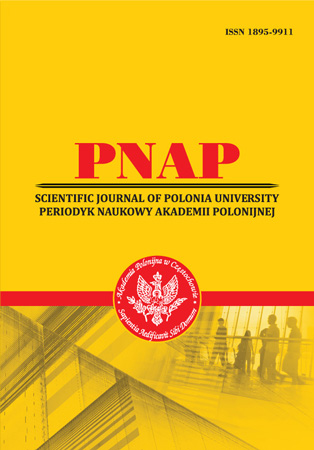PECULIARITIES OF FUNCTIONING OF POLYPROPOSITIONAL REFERENTIALLY SPECIALIZED VERBAL PREDICATES IN UKRAINIAN, POLISH, AND ENGLISH (A CORPUS-BASED APPROACH)
Abstrakt
The article analyzes the object relations of referentially specialized verbal predicates in Ukrainian, Polish, and English, identified with the involvement of functional-onomasiological methodology. We present the most common views in linguistics on the semantics of the verb as the propositional meaning core and the argument frame determinant, and, consequently, as a basis for modelling cognitive-propositional structures. In particular, a reference is made to the approaches within Ch. Fillmore’s Case Grammar and Frame Semantics, D. Dowty’s theory of proto-roles and argument selection, R. D. Van Valin’s Role and Reference Grammar, B. Levin’s perspectives on the event structure and argument realization, and others. Peculiarities of propositions that form referentially specialized verbal predicates in Ukrainian, Polish, and English are considered. Based on the Ukrainian, Polish, and English text corpora data (GRAC, NKJP, BNC), typical situations of the denotative complex “Damaging an inanimate object” are analyzed in detail. We discovered the combination of the following procedure- and event-driven situations: physical impact, pressure, the object integrity violation, destruction, the object attribute changes, the object position changes, separation, movement, touching, coating, etc. and provided examples from the text corpora. It is shown how metaphorical transfers cause the appearance of atypical items in their semantics with referentially specialized verbal predicates in Ukrainian, Polish, and English.
Wykaz bibliografii
2. Babenko L. G. (1999). Denotativnoe prostranstvo glagolov kompleksnoj polipropozitivnoj semantiki [Denotative space of verbs with complex polypropositional semantics]. In L. G. Babenko (Ed.), Russkaya glagolnaya leksika: denotativnoe prostranstvo [Russian verbal vocabulary: denotative space] (pp. 172–195). Ekaterinburg: UrGU. [in Russian]
3. Batsevych, F. S., Kosmeda, T. A. (1997). Ocherki po funkcionalnoj leksikologii [Essays on functional lexicology]. Lviv: Svit. [in Russian]
4. Croft, W. (1998). Event structure in argument linking. In M. Butt & W. Geuder (Eds.), The projection of arguments: lexical and syntactic constraints (pp. 21–63). Stanford U-ty Press.
5. Dixon, R. M. W. (1979). Ergativity. Language, 55, 59–138.
6. Dowty, D. R. (2000). ‘The garden swarms with bees’ and fallacy of ‘argument alternation’. In Y. Ravin & C. Leacock (Eds.), Theoretical and computational approaches (pp. 111–128).Oxford University Press.
7. Dowty, D. R. (1991). Thematic proto-roles and argument selection. Language, 67, 547–619.
8. Fillmore, Ch. J. (2009). A frames approach to semantic analysis. In B. Heine & H. Narrog (Eds.), The oxford handbook of linguistic analysis (pp. 313–340). Oxford University Press.
9. Grimshaw, J. (1990). Argument structure. The MIT Press.
10. Hopper, P. J. (1980). Transitivity in grammar and discourse. Language, 56, 251–295.
11. Jackendoff, R. (1990). Semantic structures. The MIT Press.
12. Lakoff, G. (1970). Irregularity in Syntax. Holt, Reinhart & Winston.
13. Langacker, R. W. (1993). Clause structure in cognitive grammar. Studi Italiani di Linguistica Teorica e Applicata, 22, 465–508.
14. Langacker, R. (1987). Nouns & Verbs. Language, 63 (1), 53–93.
15. Levin, B., Hovav, M. R. (2005). Argument realization. Cambridge University Press.
16. Levin, B. (2015). Semantics and pragmatics of argument alternations. Annual Review of Linguistics, 1, 63–83.
17. Schlesinger, I. M. (1995). On the semantics of the object. In B. Aarts & Ch. F. Meyer (Eds.), The verb in contemporary English. Theory and description (pp. 54–74). Cambridge University Press.
18. Selivanova, Je. (2000). Kognitivnaya onomasiologiya [Cognitive onomasiology]. Kyiv: Fitosociotsentr. [in Russian]
19. Selivanova, О. (2008). Suchasna lingvistyka: napryamy ta problemy [Modern linguistics: trends and problems]. Poltava: Dovkillya -К. [in Ukrainian]
20. Stefanowitch, A. (2020). Corpus linguistics: a guide to the methodology. Language Science Press. Van Valin, R. D. (2005). Exploring the syntax-semantic interface. Cambridge University Press.
21. Van Valin, R. D. (1999). Generalized semantic roles and the syntax-semantic interface. In F. Corblin, C. Dobrovie-Sorin, & J. Marandin (Eds.), Empirical issues in formal syntax and semantics (pp. 373–389). Thesus.
22. Van Valin, R. D. (2014). Role and reference grammar. In A. Carnie, Y. Sato, & D. Siddiqi (Eds.), Routledge handbook of syntax, (pp. 579–603). Routledge.
Abstract views: 205 PDF Downloads: 158







